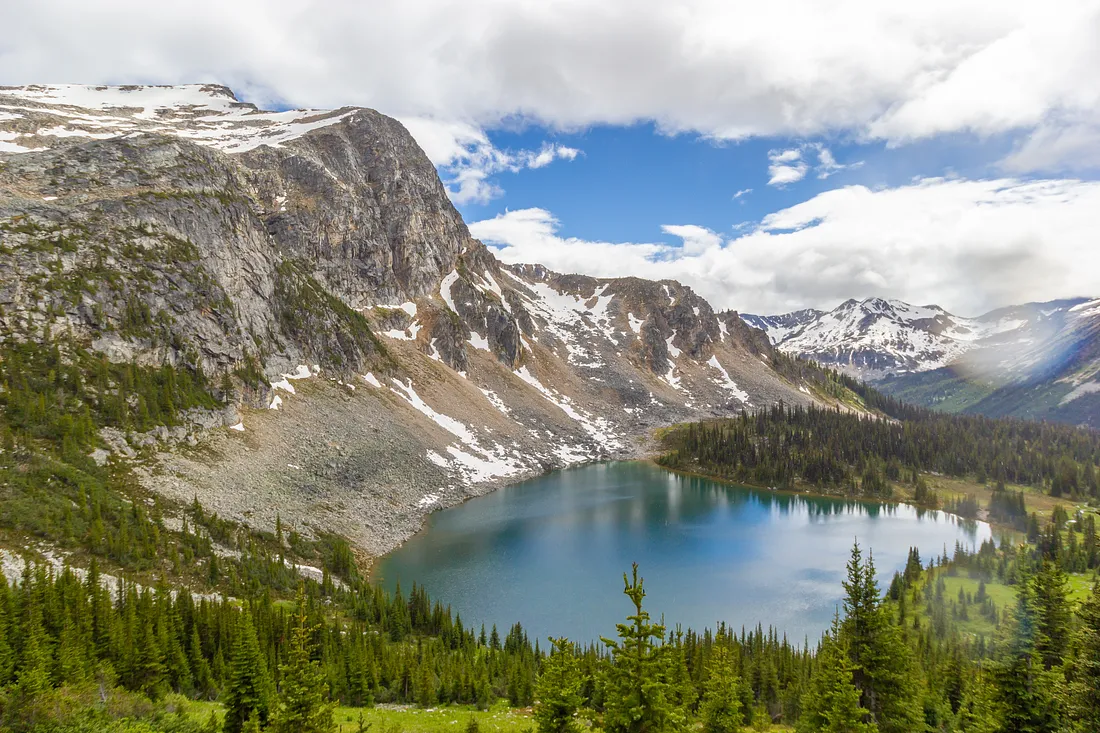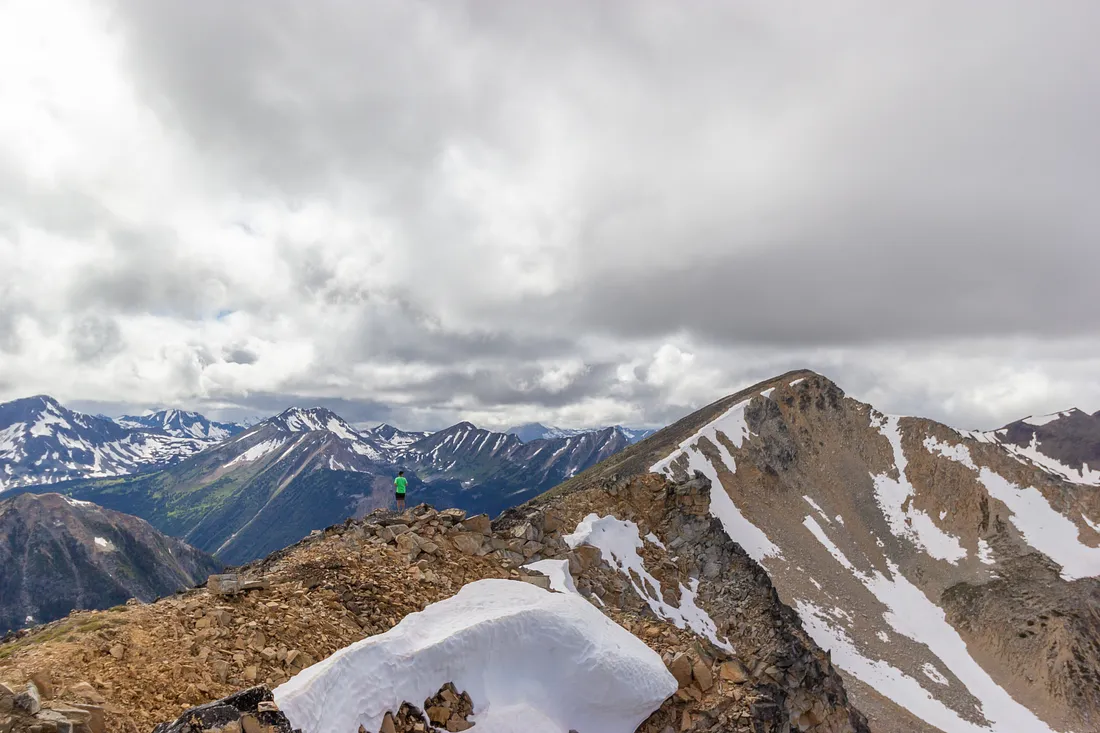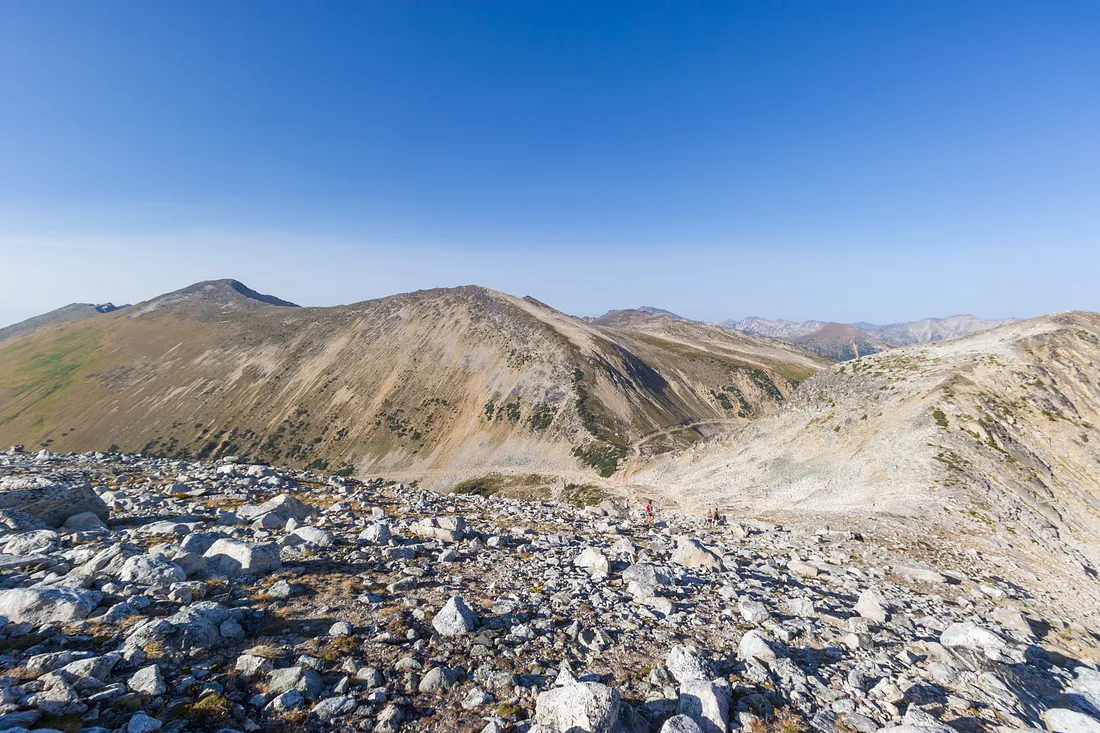Quick heads-up: some of the links on this page are affiliate links. If you make a purchase through them, we may earn a small commission (at no extra cost to you). This small bit of income helps keep our site running.
Blowdown Pass Trip Report and Hiking Guide
This trip report was last updated on December 21, 2023.

Blowdown Pass is a underrated backpacking trip and hike that is easy to get to. The lake makes a great camping spot where you can take a dip, and the surrounding peaks are great day hikes if you want to explore a little bit after setting up camp. The only downside is that if you're coming from Vancouver, it's a long drive to the trailhead.
Quick Facts
- Distance: 3.8 km to the lake
- Elevation: 390 meters of elevation gain to the lake
- Time: About 1.5 hours to the lake
- Best Time of Year: July to September
- Access: 4WD will get you to the trailhead
- Difficulty: 2/5. This is an easy hike, mostly on an old road, with enough elevation to break a sweat. Both of the peaks in the area are also easy hiking.
Essential Gear
- Backpacking Towel: The lake is a great spot to take a dip after working up a sweat on the hike in, so consider bringing a backpacking towel.
- Sun Protection: The lake is at almost 2000 meters elevation, and any hiking you do will be exposed. A sun hat is a good idea, as are some hiking pants and a long sleeve hiking shirt. Definitely also bring some sun screen and sun glasses.
- Warm Layers: Again, the lake is at almost 2000 meters, so no matter how hot it gets during the day, it's going to cool down at night. I would recommend a down jacket, and either some long underwear or some down pants, depending on just how cozy you want to get.
Directions to the Trailhead
Getting to the trailhead is straight-forward, but from Vancouver is a long trip (about 3.5 hours). From Vancouver you head North to Pemberton and the Duffey Lake Road. You'll want to drive all the way past Duffey Lake. Shortly after you pass the lake you will see two gates (that should be up) on either side of the road. Directly after the gates there will be a logging road or FSR on your right, that cuts steeply back. This is the Blowdown Pass FSR, which you want to take.
After switch-backing a couple times to gain elevation the road is fairly flat and in decent condition. There are a few minor water bars to get through, but most 4WD vehicles should be able to make it to the trailhead without any problems.
After about 10 km you come to a fork in the road, which is where most people will park. The road cuts back to the left at this point and narrows. If you don't mind some aggressive alders you could keep driving, but your paint job will suffer. This trail is popular with ATVs and dirt bikes, so keep an eye (and ear) out.
The Hike
Most of the hike is just a continuation of the logging road you drive in on. The road switch backs a couple times, gaining elevation, and then lessens off a bit as you traverse across the valley towards the pass.
After a few kilometers you will start to see the lake come in to view down to your right, below the road you're hiking on. If you're planning to camp at the lake, there will be a few different trails that cut down to the lake, take whichever one looks the best. From here it's just a quick downhill hike through the open alpine forest to the lake.
If you're not camping at the lake, you can continue on the old you're on, it should take you just about all the way up to Blowdown Pass.
Camping Options
The best camping option by far is Blowdown Lake, which is located just below Blowdown Pass.

There is a lot of open space along the Northern shore of the lake that is flat and usually dry, that makes a great spot to set up camp. There is enough space that several different groups can all set up and have some space, so you don't really have to worry about hurrying to the lake to get a spot.
This is a lesser known spot (currently) so you can expect to see a few other groups camping at the lake, but probably not a lot of people. The lake is also warm enough to go swimming in if it's warm out, so do bring your backpacking towel if you're feeling like a swim.
Nearby Mountains
There are a couple great mountains that are easy hikes from the lake.
Gott Peak

Gott Peak is the peak of North of Blowdown pass. To get to the peak you start by hiking back up to the road you hiked in to the lake on. From there, you follow the road all the way to Blowdown Pass.
The road continues through the pass in to the next valley, but at that point you'll want to leave the road to the left and start hiking up the ridge. There should be a trail, but the hiking is easy and and the terrain is very open, so follow whatever line looks best to you.
After a bit of a steep hike you gain the top of the ridge, and things level out. From here you just traverse the ridge until you reach the high point. There's no challenging scrambling, and you get plenty of amazing views.
To get back to the lack you can retrace your steps, or you can head straight down, back to the road below if you're feeling adventurous. The grassy slopes can be a bit slippery but if you take it slow it's a nice shortcut. There will be a bit of a bushwhack at the end, but you will end up back on the road, and you can follow that back to the lake.
Gotcha Peak

Gotcha Peak is another great hike from Blowdown Lake.
From the lake you ascend back up to the old road that you hiked in to the lake on, and then follow that road up to the official Blowdown Pass.
From here, you take a left to head up to Gott Peak, and a right to go up to Gotcha Peak.
The terrain up the slopes of Gotcha is bouldery but open and not challenging. There will be some small signs of a trail, but you can follow whatever path looks best for you.
The top of Gotcha Peak is a wide open area. You can explore around a bit and get some great views, including a nice view of the lake below.
There is a way to keep going off the other side of the peak and make a loop back to the lake, but it involves some more moderate scrambling sections, so if you're not looking for a challenge the best route back to the lake is the way you came.

FAQ
Are there bears at Blowdown Pass?
There is definitely the possibility of seeing a bear at Blowdown Pass. It's also far enough North that there is a chance that you will see Grizzlies too. So make sure you bring your bear spray, and either a bear canister or a hanging system. There are enough trees around that you can hang your food.
Can I bring my dogs?
Yes! Blowdown Pass is not a park so you can bring a dog.
What is the best time of the year to camp at Blowdown Pass?
Like a lot of alpine lakes, the best time to camp at Blowdown Pass is July through September. Before July there may still be some snow around. After September it will be cold and maybe rainy (or snowy!).
Are there a lot of bugs?
The area around Blowdown Lake is wet and can be a little marshy in places, so it's definitely a spot where you will find mosquitos, if it's a bad mosquito year.
Is there a permit I need to get?
You don't need any kind of permit. Go whenever you want, and treat the area with respect for the next person.
Can I have a campfire at Blowdown Pass?
Yes, as Blowdown Pass isn't inside a park, you can have a campfire there, as long as there is not currently a fire ban. Please do bring your own wood if you're going to have a campfire. Trees are sparse and grow slowly in the alpine environments. Cutting them down has a real, negative impact on that fragile environment.
Gear Packing List
Sleeping + Shelter
- Sleeping bag
- Sleeping pad
- Pillow
- Tent
- Tent pegs
- Tent footprint
Cooking + Eating
- Stove
- Propane (or other fuel source)
- Lighter
- Pot and / or Pan
- Bowl / Plate
- Spork
- Biodegradable dish soap
- Breakfast
- Lunch
- Dinner
- Snacks
- Coffee (or tea)
Water
- Water bottle
- Water filter (the lake water is relatively clean, so purification tablets will work too)
- Mug for hot drinks
Packing
- Backpack
- Backpack rain-cover
- Zip-locks and / or trash bag
- Food storage bag
- Bear Canister or hanging system
Feet
Hygiene
- Toilet paper
- Toothbrush + toothpaste
- Soap (make sure it's biodegradable)
Clothing
- Underwear
- Long underwear
- Base layer
- Down jacket and / or fleece
- Shirts
- Shorts or Pants
- Rain jacket (if the weather calls for it)
- Rain pants (if the weather calls for it)
- Hat
Around Camp
- Headlamp (plus extra batteries)
- Backpacking chair
- Backpacking towel (if you're thinking about taking a dip in the lake)
- Knife
Misc
- Trekking poles
- Sunglasses
- Camera
- Cord or rope
- Bear spray
- First aid kit
- Mosquito spray
- Sunscreen
- Duct tape
